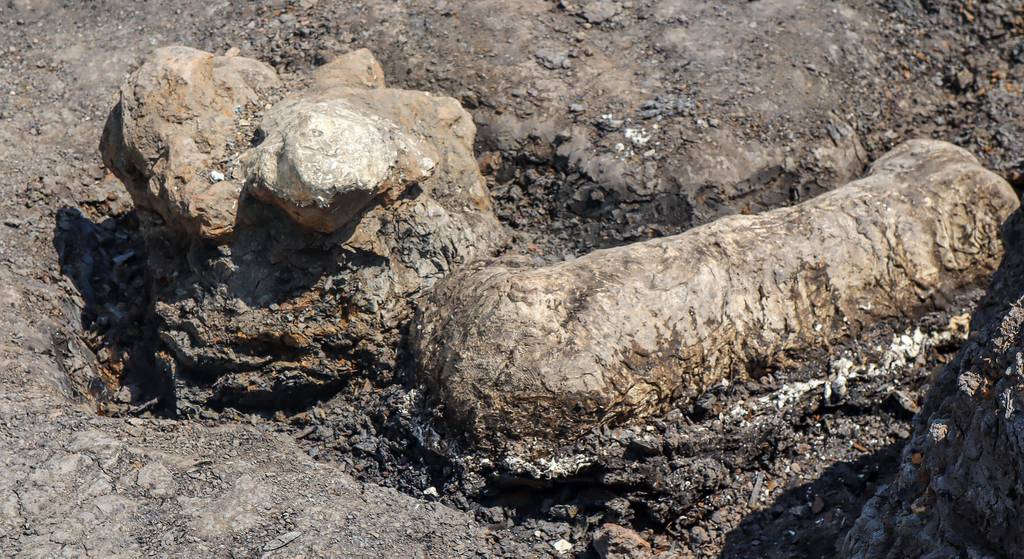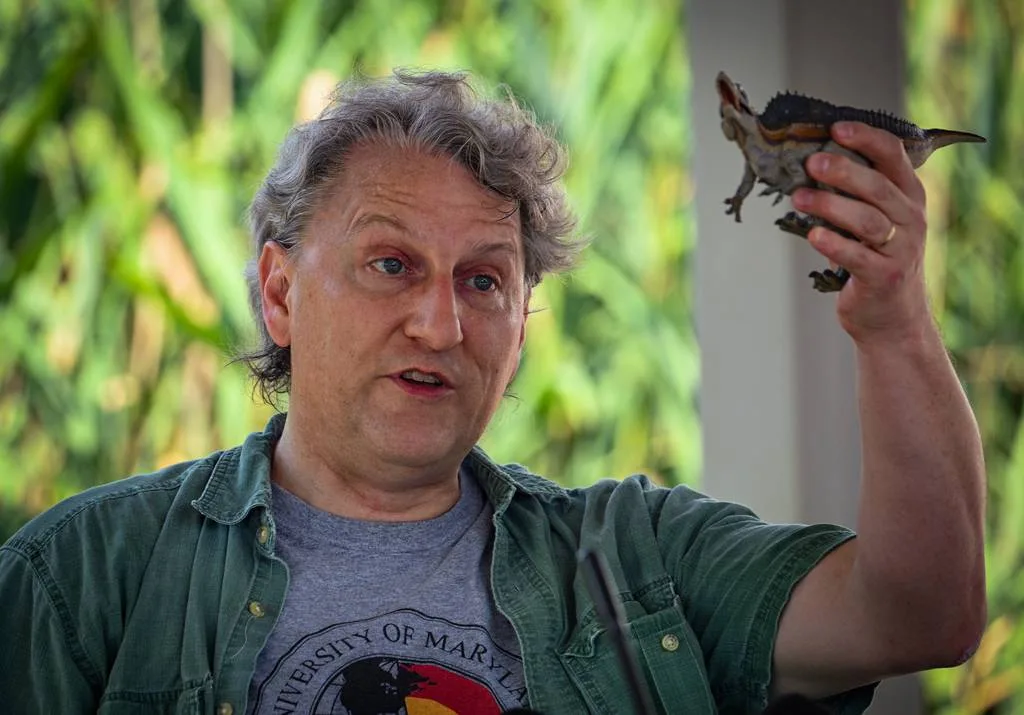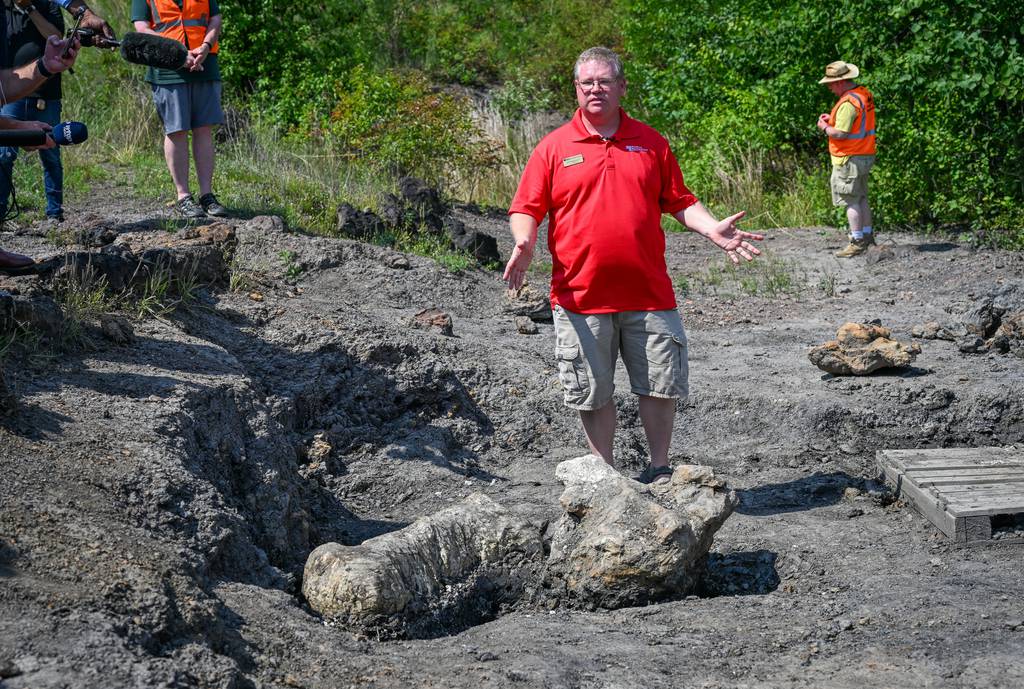When Argentine geologist Federico Alvarez Hazer immigrated to Baltimore one year ago to live with his wife, he imagined that his days working on fossil dig sites close to home — as he had in South America’s Patagonia region — were over.
He was surprised to discover Dinosaur Park, a 3.63-acre site nestled behind a business park in Laurel that was preserved following the discovery of several fossils more than 100 million years old.
And he was amazed when he quickly found himself involved in a noteworthy discovery at the park, displayed at a news conference Wednesday.
It was Alvarez Hazer’s hammer that struck a dinosaur’s 3-foot shin bone, which was buried in dirt. It happened during an Earth Day event, while he was helping excavate a dinosaur vertebra just inches away.
Dinosaur Park staff members say both of those bones, and numerous others, are part of a prehistoric “bone bed.” It’s the first discovered in Maryland since 1887, according to a news release from the Prince George’s County Department of Parks and Recreation.

The shin bone might be the collection’s crown jewel. Local experts believe it’s the largest theropod fossil discovered in Eastern North America.
“I was working with my hammer, and I broke a part of the tibia bone, and I said, ‘Oh, s—, a bone,’” Alvarez Hazer told The Baltimore Sun. “We start to dig and it was long, long, long.”
Theropods are a class of large, three-toed, carnivorous dinosaurs that include the Tyrannosaurus rex, though the bones discovered at Dinosaur Park predate the famous dinosaur.
The initial hypothesis is that the shin bone belonged to an Acrocanthosaurus. At approximately 38 feet long, that dinosaur would have been the largest theropod in the early Cretaceous period, which was more than 100 million years ago.
Alvarez Hazer was on the team Wednesday that used shovels to carefully lift the shin bone from the dirt (an effort punctuated by a group hug) and place it on a forklift. The bone bed also included a 4-foot-long limb bone belonging to an unidentified massive dinosaur. It was shrouded in protective burlap and plaster and taken from the site.




The list of bones discovered on the bed since 2018 is extensive: a tail barb from a stingray, which could be the second oldest found worldwide; the tooth of a small tyrannosaur, the first evidence of a distant T. rex relative in Maryland; an ankle bone, claw and vertebrae from an ostrichlike dinosaur called an ornithomimid.
The discoveries hold important clues to understanding the prehistoric past of Eastern North America, which is often covered by development and heavily forested lands, said Thomas Holtz, a University of Maryland paleontologist who was the first to confirm the theropod discovery at the park.
“Where we don’t have greenery on it, we’ve got light industrial parks, or shopping malls or houses or whatever. So we don’t have those rocks exposed,” Holtz said. “And because of that, our knowledge of the dinosaurs from the Eastern part of North America has been lacking compared to what we know about in the West. But this site is helping to change that.”
Back in the 1800s, the Dinosaur Park site was an iron mine, and African American miners were the first to discover dinosaur bones in 1858, according to the park’s website. About a year later, geologist Phillip Thomas Tyson brought the bones to a meeting of the Maryland Academy of Sciences, where his colleagues identified them as those of dinosaurs.
Then, in the winter of 1887, paleontologist Othneil Charles Marsh of Yale University sent fossil collector John Bell Hatcher to search the iron mines for more fossils. Hatcher recovered hundreds.
Organized fossil collecting on the site essentially stopped when iron mining came to a halt there in the early 20th century.
By the 1980s, paleontologists revived interest in the site, and since October 2009, the Maryland National Capital Park and Planning Commission has protected it from development and unrestricted collecting.
Dinosaur Park is open to the public on the first and third Saturdays of each month. Digging isn’t allowed, but park staff members guide visitors as they look for fossils on the surface. Over the years, young children eagerly scanning the rocky area for traces of the extinct have made several discoveries.
The story of the recently announced bone bed dates to 2013, when Dinosaur Park staff member Max Bovin spotted an exposed section of bone in the dirt, which was later determined to be the 4-foot limb. At that time, staff members elected not to disturb it.
The bone had the blue-green tint that park staff members tell visitors to look for when searching for fossils, Bovin said. Leaving it in place made it a great instructional tool for the hosts of enthusiasts, young and old, who visit the park during guided fossil hunts.
But there was another reason the bone was left undisturbed. It was encased in ironstone, a class of sedimentary rock that is “a real pain to work with” because of its dense deposits of iron, said JP Hodnett, paleontologist and program coordinator at Dinosaur Park.
“The best course of action sometimes is just to let nature kind of take its course,” Hodnett said. “Maybe it’ll soften the sediments, maybe it will help expose them more, so we know how much it is without having to really put in a lot of effort and energy to crack open something and it could just be nothing.”




Over time, the bone became even more compelling. In 2014, while clearing brush, a piece of heavy landscaping machinery struck the ironstone, breaking off a chunk and revealing more of the bone.
“I came out one day and the whole end of it was cracked off — the ironstone that the bone is inside of,” Bovin said.
By 2018, shortly after Hodnett started working at Dinosaur Park, staff members decided to excavate the bone to preserve it, he said. After delays, including some due to the coronavirus pandemic, the effort began in 2021, Hodnett said.
As the team of excavators made its way around the bone, it found more fossils: A vertebrae here, a tooth there.
”That made us go, ‘Wait, there’s something special going on here,’” Hodnett said.
Then came this year’s Earth Day event, when volunteers stumbled upon the tibia.
Madison Mateo, a rising junior studying geology at George Mason University, was volunteering at the site when the tibia was found. She returned over the following days as more of the bone was uncovered — between classes, of course.
The Rockville native said she had always figured she would need to travel to the West Coast to be involved in fossil digs, and was surprised to learn about the Laurel site.
“It was very exciting to have something like this so close to me,” she said.


